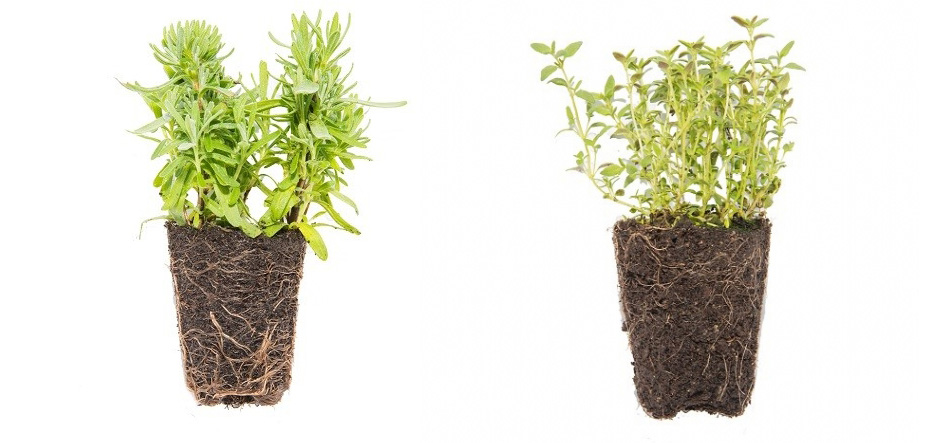How to make planting material for trees and shrubs?
How can you grow trees, shrubs or other planting material on places where there is – for example – little precipitation, a warm climate or there is too much rain?
Different types of planting material
The success of plant growth after initial planting depends very much on the planting material and its root system. To plant trees in an efficient and good way, we mention the 5 most important (common) options for planting material:
- Option 1: Seed (from F1 hybrids, from variable populations, etc.);
- Option 2: a 1 year old saplings on plugs (from seed, cuttings, tissue culture, etc.);
- Option 3: a 2-year-old saplings on pots;
- Option 4: a 1 year old saplings with bare roots;
- Option 5: a 2 or more-year-old sapling with bare roots.
Option 1: Planting seeds in the Waterboxx® plant cocoon
Many experiments are done with the Waterboxx® plant cocoon. it doesn’t matter under which circumstances or in which climate you plant, but growing seeds seed in the center opening of the Waterboxx® plant cocoon is not a success. There are several reasons for this, the 2 most important reasons are:
- The seed doesn't germinate when it is sown outside its natural germination period;
- Other seeds (mainly grasses) germinate so well, that they grow faster than the tree seed, and suffocate it.
Conclusion: do not sow seed directly in the soil with the help of the Groasis Waterboxx® plant cocoon, but use other planting material.
Option 2: Growing a young tree out a plug
In general, saplings from cuttings or seeds are planting into a little space using plastic plugs in greenhouses, and afterwards, they are transplanted into bigger pots outside.
Plugs with a cutting
After the cuttings are planted, its root system starts to develop. If the rooting is successful, the cutting generally develops more than one root. These roots are also called primary roots. If we take these saplings from the plug without damaging the primary roots, these primary roots will have substantial power to grow into dry soil or rocks, but they have less power than a radicle from a seed.

Plugs with a seed
The seed will develop a radicle in the plug with the same power to break rocks as when sown directly into the soil.
Option 3: Growing a young tree in pots
The cuttings can be planted immediately in the ultimate pot in which it will be sold; the root system will then be destroyed in the plastic pot as described in Option 2. But many times, the trees planted in plastic pots are transplanted from a plastic plug. If during this transplanting from the plug into the pot, the primary roots are damaged, then re-growth of these roots will happen. But each root that re-grows will produce roots that are weaker than the original. These roots have less power to enter dry soils or rocks, and that’s why you have to use other planting material.
The downside of using a plastic plug or pot
But, using a plastic plug or pot has two negative characteristics. First of all, once the root starts to grow rounded instead of vertically downwards, they will have a lot of difficulty growing vertically after planting. Many times, they won’t. So, if you have a rounded horizontal growing pen root in the plug or pot, this sapling is not useful for dry soils or rocks. It will fail. There is a solution to repair this problem. You will learn about this solution further down the page. You can prevent pen roots from growing horizontally rounded by choosing plugs or pots with a design that stimulates roots to grow vertically downwards. Choose a reversed pyramid model, a square one, or a model where the inside is unequal. Look at the images for an example of a well-designed plant plug.
The second negative characteristic is that once the radicle grows well and vertically, it will come to the bottom of the plug. If at that moment the plug is not planted, the radicle will stop growing downwards, and it will lose a part of the active apical meristem cells. The radicle will split into many small primary roots which have less power to break into dry soil or rocks. Besides, this the radicle will start to grow upwards again, and then start to grow horizontally rounded. Once growing this way, it will never change this habit. This means that if you plant a plug with a radicle root growing horizontally rounded, this root will never turn downwards and grow into the dry soil and rocks. If you are lucky, some of the radicles will develop a new root growing downwards - but the majority will not.
This is why planting trees on rocks or trees in dry or eroded areas, which are pre-rooted in plugs, will mostly fail unless they get help through irrigation. In 2007, Pieter Hoff, inventor of the Groasis Ecological Water Saving Technology had planted as an experiment, saplings of Metasequoia glyptostroboides. These were one year old trees multiplied through cuttings and had pen roots growing horizontally rounded in the plugs. He took them out in December 2009, two years after planting. On the images, you can see that most of the pen roots did not recover, and less than 20% of the surviving saplings had developed a new pen root. Over 50% of this trial which was planted on a dry sandy soil in Holland – a country with sufficient rain – died. You can see on these images, this bad phenomenon of non-recovered rounded pen roots.
Groasis has developed a solution for these problems. The solution is called the pen root paper plug. The pen root paper plug allows you to plant trees, bushes or vegetables with an intact pen root. Read all about how to get the best pen root to do reforestation and anti/desertification in order to solve your planting problems. The pen root paper plug is the best solution to plant trees, bushes or vegetables in deserted, eroded, sandy, arid or rocky areas.
Option 4 and 5: Trees with bare roots
With bare roots the root system is heavily damaged while taking them from the soil to re-plant in their final place. In general, the primary roots are destroyed and the tree is not qualified to be planted in dry soils or on rocks. Trees planted with bare roots will not survive in a dry soil or on rocks without using irrigation.
How to repair destroyed primary roots?
This photo series shows you how to repair them: destroyed horizontally growing pen roots can be repaired. Look at these photo series how you can do this.
This photo series shows you the result of repairing the destroyed pen roots: Check these photos to see how the pen roots recover after 4 weeks if you cut them up to the vertically downwards growing part.
Plants with repaired pen roots are the second-best solution to planting trees, bushes or vegetables in deserted, eroded, sandy, arid or rocky areas.
Radicle or Pen root? Conclusion
You now understand that the most important criterion for successful planting in deserts or on rocks, is keeping intact the radicle or pen root. Some tree species have a better pen root than others; some species have a characteristically divided root system; and other species have a specific pen root that remains intact over their whole life. For planting in dry soils or on rocks, we prefer tree species with this specific "pen root". This primary root is able to penetrate very dry soils or rocks deeply. Some roots have been found to a depth of over 60 meters!















